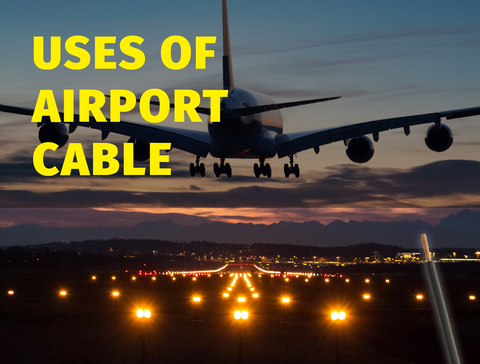Tipos de cables de aeropuerto y sus aplicaciones
Los aeropuertos requieren tipos específicos de cables para garantizar la seguridad de sus operaciones. Entre los cables utilizados se incluyen los cables de iluminación de aeródromos, los cables de los edificios de terminales, los cables de las unidades de energía terrestre y muchos otros. Los cables de iluminación son esenciales para las operaciones aeroportuarias.
Los cables de alumbrado público son adecuados para diversas instalaciones, como conductos, ductos o enterramiento directo. Debido a su uso en aeropuertos, se espera que sean extremadamente eficientes. Además, se espera que no requieran mantenimiento durante al menos cinco años tras el inicio de operaciones.

Los cables pueden tener conductos metálicos y no metálicos. Están diseñados para diversas aplicaciones aeroportuarias, como sistemas de iluminación, circuitos de iluminación, circuitos de control y equipos de control.
Todos los cables de aeropuerto son resistentes a la luz solar, una característica esencial dadas las especificaciones de su uso. Además, se caracterizan por un equilibrio óptimo de características eléctricas y mecánicas que garantiza una larga vida útil. Estos cables tienen un solo conductor de cobre desnudo trenzado y recocido, con un calibre de entre 12 AWG y 4 AWG. Los conductores tienen trenzado de clase B según ASTM B 8 y son resistentes al calor, lo cual es necesario ya que el uso prolongado puede provocar sobrecalentamiento.
Tipos de cables de aeropuerto
Cables de iluminación de aeródromos
Los cables de iluminación de aeródromos se utilizan en sistemas de iluminación, circuitos de iluminación, circuitos de control y equipos de control aeroportuarios. Son adecuados para pistas, calles de rodaje, ayudas a la navegación, sistemas de control e iluminación de obstáculos, incluyendo LED y xenón. Pueden utilizarse para diversas aplicaciones de conductos, ductos, antenas, canalizaciones y enterrados. En las pistas, los cables de iluminación desempeñan un papel crucial, ya que garantizan la visibilidad nocturna de los pilotos. También les ayudan a determinar su ubicación exacta en el aeródromo. Además, los pilotos necesitan luz para ver la pista que tienen delante.
Cables del edificio terminal
Los cables de las terminales aeroportuarias se utilizan en terminales de pasajeros y escaleras mecánicas. Gracias a su resistencia al fuego, se emplean con frecuencia en sistemas de extinción de incendios y en diversas aplicaciones dentro del aeropuerto.
Cables de la unidad de potencia terrestre de la aeronave
Los cables de alimentación de tierra de aeronaves son cables GPU que se utilizan en las unidades de alimentación de tierra para que la aeronave funcione correctamente durante su estacionamiento. Estos cables son energéticamente eficientes y flexibles. Las GPU proporcionan la potencia de 400 Hz necesaria para el funcionamiento normal de los cables.
Cables de señalización, control y alimentación
Los cables de señalización, control y alimentación se utilizan en equipos de rayos X, sensores y cintas transportadoras. Son ignífugos para proteger a empleados y pasajeros de incidentes relacionados con humo y gases corrosivos.
Instalaciones
Los cables están aislados con polietileno reticulado (XLPE) negro, que ofrece un nivel de control de tensión semiconductor. El aislamiento de XLPE proporciona a estos cables resistencia a la vía, la abrasión, la humedad, los fluidos químicos y el calor. Este material reduce los niveles de cortocircuito y sobrecarga.
Los cables están disponibles en versiones de 600 o 5000 voltios y están aprobados para enterramiento directo. Las versiones de 5 kV se utilizan en los circuitos primarios entre la fuente de corriente constante. Los cables de iluminación de menor voltaje, de 600 voltios, son adecuados para circuitos secundarios donde la durabilidad no es tan crítica.
Los cables se entierran directamente bajo las pistas de los aeropuertos. Los lugares con circuitos enterrados directamente y las ubicaciones de las conexiones de cables se identifican mediante marcas distintivas según las normas. Los cables enterrados directamente son resistentes como medida de precaución.
Generalmente, los cables se entierran en conductos para alimentar luces en serie y luces de navegación (LED). Al utilizarlos en conductos, los cables no deben tener conexiones ni empalmes. Se debe aplicar una cinta semiconductora helicoidalmente sobre el aislamiento, ya que la atmósfera en los conductos puede ser bastante húmeda. El blindaje ayuda a prevenir accidentes en aeropuertos al minimizar la pérdida de energía. También ayuda a mejorar la durabilidad del equipo. Los conductos más bajos deben ser los primeros en recibir los cables. Las rutas de los conductos también deben ubicarse lo más abajo posible, sin interferencias, para un uso más eficiente. Los bancos de conductos y los conductos se instalan por separado según las normas.
El rango de temperatura de los cables aeroportuarios varía desde 90 °C en operaciones diarias hasta 130 °C en casos de emergencia y 250 °C en aplicaciones de cortocircuito al exponerse a calor extremo. Algunas de las normas de la industria que cumplen los cables aeroportuarios incluyen ICEA S-66-524, FAA-L-824 y RoHS.
Tipos de cables de aeropuerto disponibles
El cable L284 tipo C que ofrece Nassau National Cable está diseñado específicamente para sistemas de iluminación de vías respiratorias. Sus características minimizan el impacto potencial del calor. La longitud predeterminada del cable es de 1524 m (5000 pies), pero hay otras medidas disponibles a solicitud.
También disponemos de versiones alternativas de cables con cobre estañado, blindaje y diferentes colores bajo pedido. Los cables de iluminación para aeropuertos de 5 kV y 600 V de Nassau National Cable se fabrican exclusivamente en Estados Unidos, lo que garantiza su máxima calidad.


















